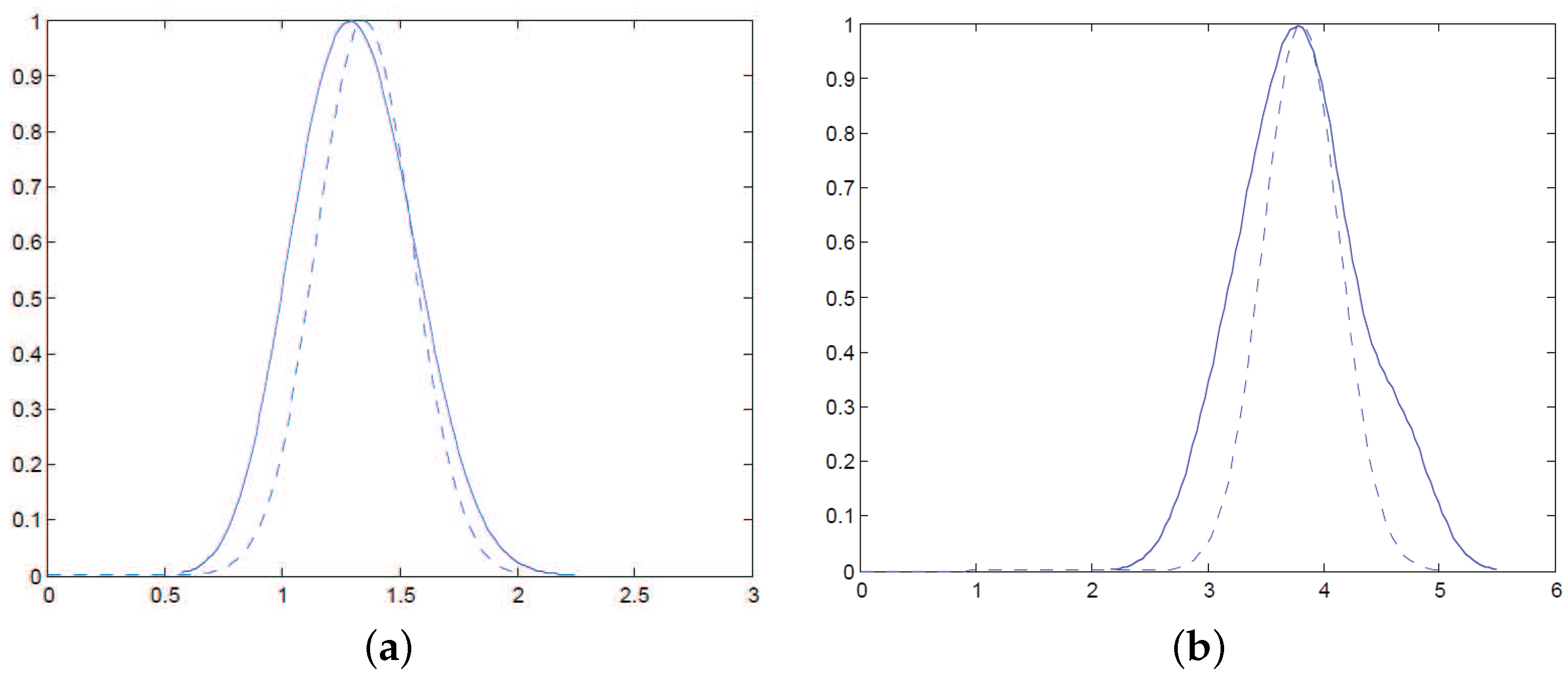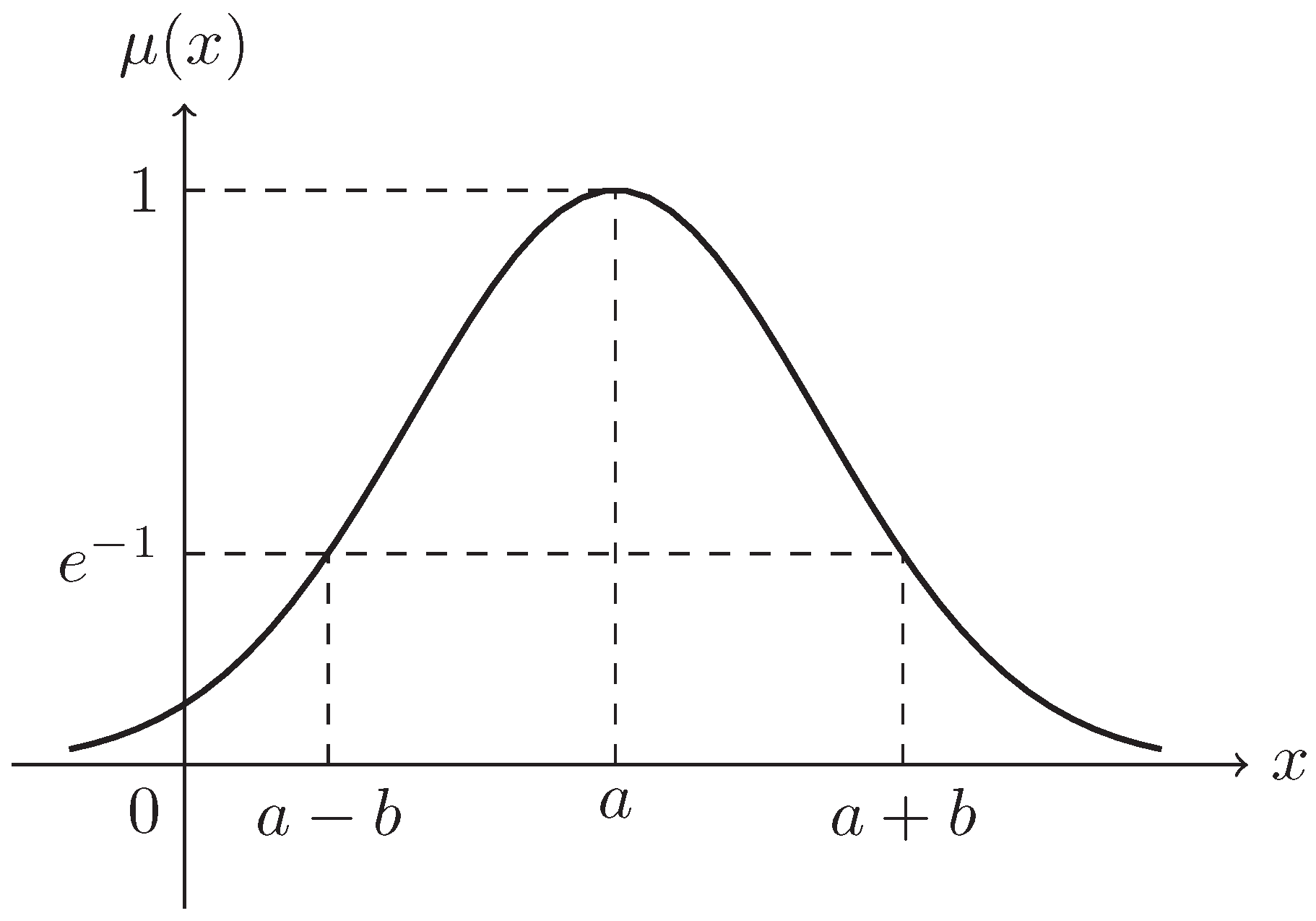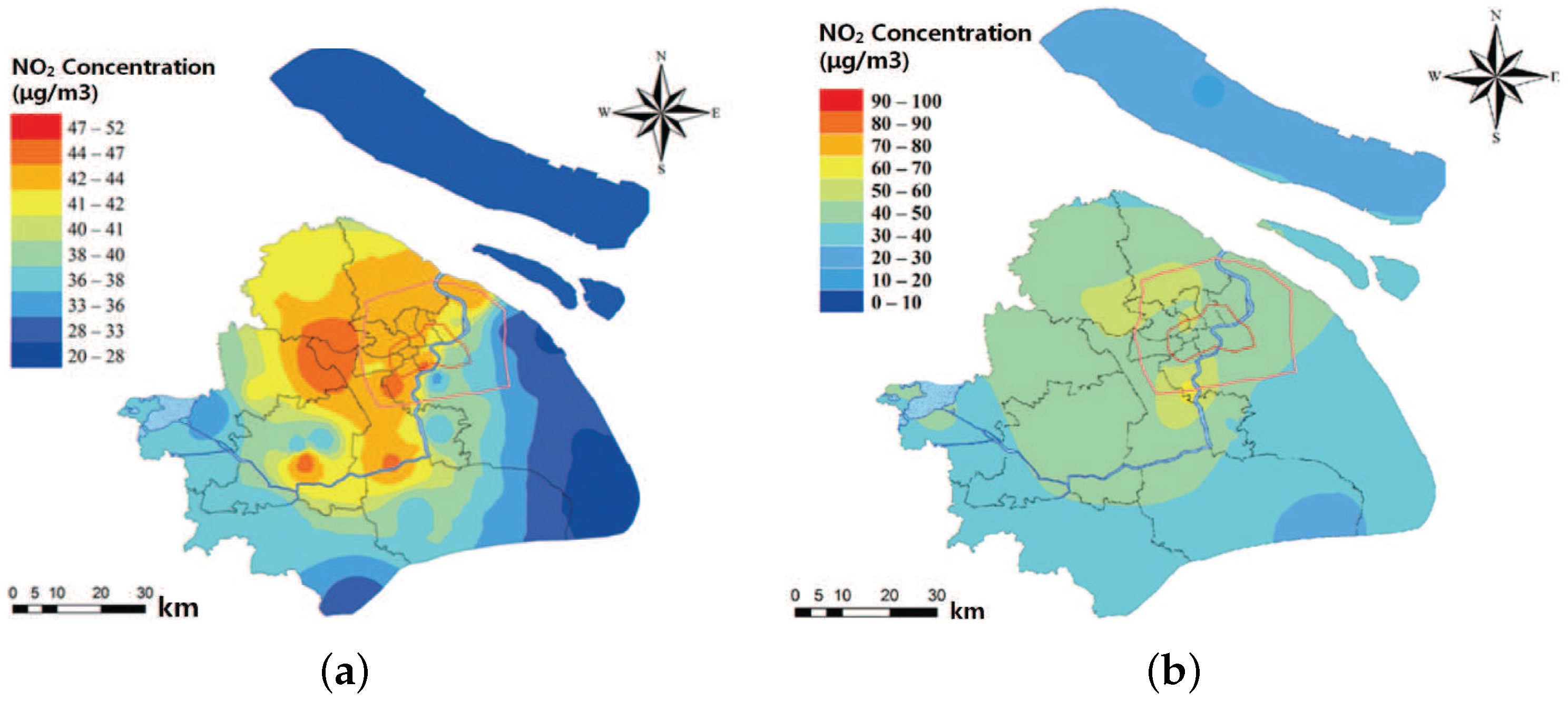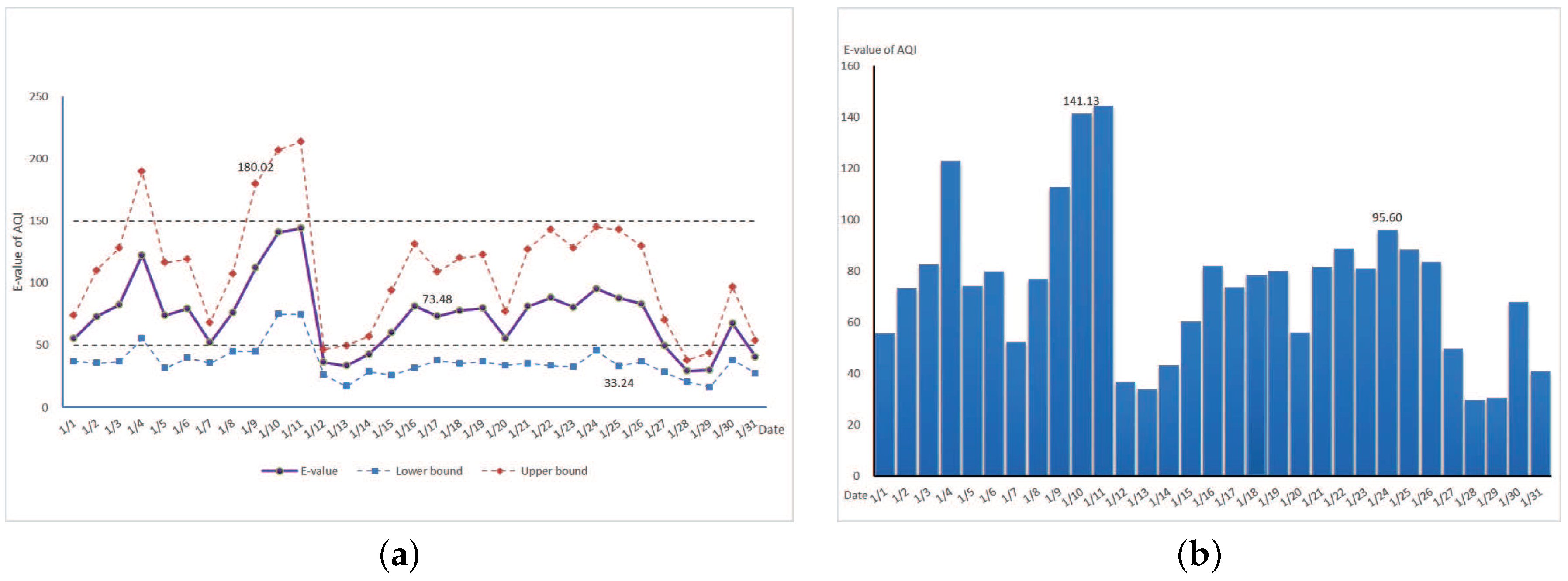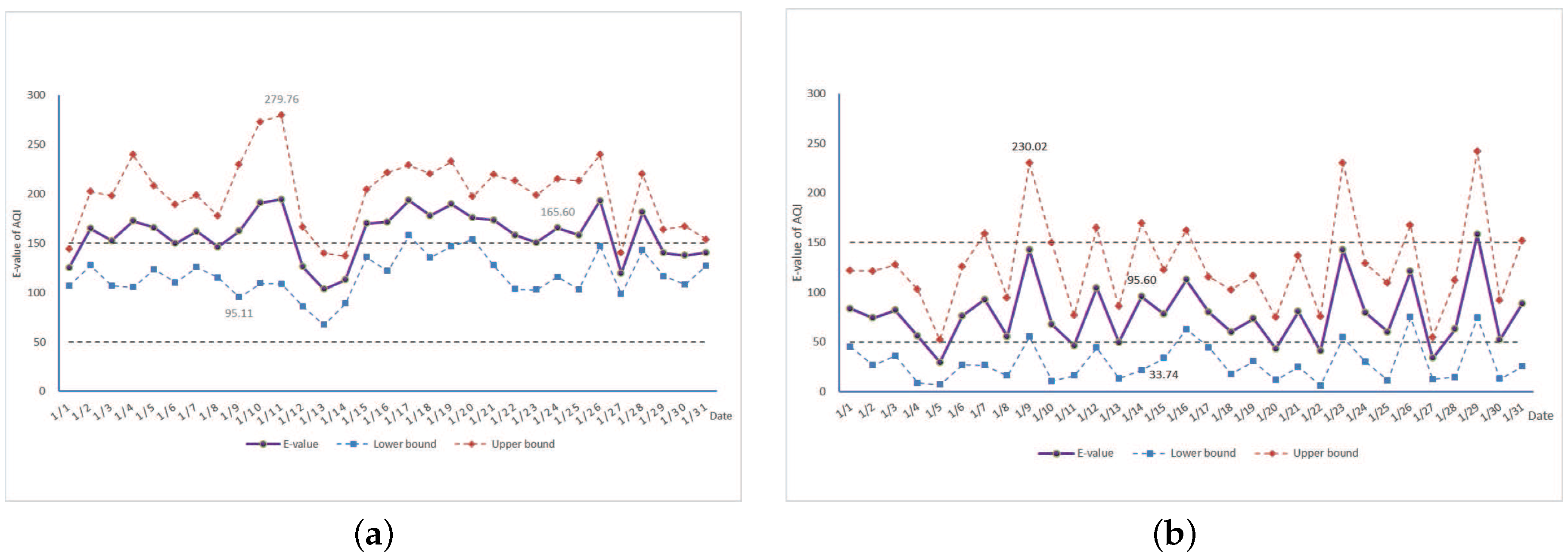1. Introduction
With the rapid development of the social economy and the remarkable improvement of people’s living standard, a healthy and comfortable life has gradually become the mainstream that more and more people chase. Meanwhile, environmental problems especially air pollution have gotten increasing attention, which are threatening the public health in a potential way across the world. Therefore, it is necessary for environmental protection departments to take some realistic effective measures to make the public know about the current air quality status, as well as associated health effects clearly. So far, many indices have been adopted to qualify the air quality level, so as to release the real-time air quality by the authority more conveniently. Such indices were firstly suggested by Lyndon and Babcock [
1] in the early 1970s and had been vigorously developing since then. Among them, the Air Quality Index (AQI) has become the most widely employed index since it was pioneered in 1993, which is deemed to be a standardized summary measure of ambient air quality in many countries. Nowadays, the AQIs put forward by different scholars or organizations remain diverse, one of which gets more recognition, that proposed by the United States Environmental Protection Agency (USEPA) in 1998 that is calculated in terms of the concentrations of several representative pollutants. At present, the constitution of the criteria pollutants adopted by most countries in the world is ground-level ozone (O
), PM
, PM
, carbon monoxide (CO), sulfur dioxide (SO
) and nitrogen dioxide (NO
).
In the past decades, in order to conduct an integrated assessment for different pollutants, Hamekoski [
2] built a simple AQI model on account of the Pollutant Standard Index (PSI) developed by the U.S. EPA. Afterwards, Ott and Hunt [
3] proposed a non-linear standardization to quantify the impact of each pollutant on air quality, whose transformation was used by the U.S. EPA later. In addition, Swamee and Tyagi [
4] put forward its linear standardization. Based on their research, these methods were diffusely applied into the practical air quality evaluation. For instance, Nagendra et al. [
5] carried out an empirical study on the air quality evaluation not only at the residential, but also at curbside monitoring stations in some specific cities or countries. More practical applications of the AQI can be referred to [
6,
7,
8,
9,
10,
11].
Subsequently, a great deal of studies on alternative indices was largely performed. According to the suggestions put forward by Swamee and Tyagi [
4], Kyrkilis et al. [
12] developed an aggregate AQI for Athens, Greece. Since the aggregate AQI does not clearly explain the established exposure-response relationships among the pollutants, Cairncross et al. [
13] proposed a health-risk-based AQI. Wong et al. [
14] and Hu et al. [
15] respectively applied the aggregate AQI and the health-risk-based AQI to different regions to characterize the multi-pollutant air pollution. From the perspective of time span, Mayer et al. [
16] set forth the daily AQI, and it was successfully utilized by Kumar and Goyal [
17] to predict the daily air quality status. After that, Mayer and Kalberlah [
18] presented a specific computational formula for long-term AQI, which was similar to the formulation of the daily AQI. Mayer et al. [
19] analyzed the evolution of the integral long-term air pollution in SW Germany in terms of long-term AQI. Furthermore, taking the variety of the standard pollution concentration levels among different countries into consideration, Cheng et al. [
20] discussed the optimal method to evaluate the air quality in Taiwan via the revised AQI initiated by Cheng et al. [
21], which is an alternative system of the PSI and AQI system.
On the whole, most of the literature adopts the maximum operator to obtain the overall AQI. The intraday AQI depends on the pollutant with the highest Individual Air Quality Index (IAQI). Clearly, this method overlooks the impacts exerted by other pollutants on the air quality. Consequently, to obtain an integrated AQI and reflect the influence of each pollutant on air quality comprehensively, the weighted arithmetic mean function is suggested. Mandal et al. [
22] brought up a method that calculates the weighted average of IAQIs as the overall AQI, in which the weights are usually obtained by using the analytical hierarchy process (AHP). Kone and Buke [
23] performed the air quality evaluation of Turkey in terms of the air pollution index, which was also derived from the weighted value of four different environmental threat categories. Additionally, Li et al. [
24] studied the weighted combined air pollution index to communicate the health risks in Guangdong, China. Apart from the above research methods, some novel AQIs based on the fuzzy synthetic evaluation [
25,
26] and fuzzy inference system [
27,
28,
29] have been discussed from the point of view of theoretical studies.
As an index of reporting the daily air quality, the AQI has been adopted by many countries currently. In China, the environmental monitoring centers situated in different cities or provinces will release the real-time AQI, the corresponding air quality level and health guidelines to the public via their official websites or other media, which contribute to people realizing the air quality in the region where they are located. In practice, when making a tourism plan, people usually choose several cities as alternatives. However, which one will be chosen as the final destination sometimes relies on other relevant factors, such as local customs, climate, air quality status, and so on. There is no doubt that all people prefer a place with a good air quality to relax. Thus, it can be seen that the AQI as an index of measuring the air quality status plays a critical part in the process of making a travel plan. However, when the public wants to look up the historical data about the AQI (i.e., the AQI values exceeding 24 h or more), the information that they can acquire is just a total intraday AQI denoted by a mean value. It is somewhat one-sided to use the mean value to represent the AQI of the whole day, because the information about raw data illustrated by the mean value is fairly limited. Additionally, in many cases, people may want to know not only the numerical values, but also the overall fluctuation or change of air quality during a certain period of time when they formulate a travel plan. Normally, the AQI with a smaller fluctuation range indicates that the air quality is more stable. If several cities have a similar air quality level, the one with a smaller fluctuation will be considered first for most people, especially the groups who are extremely sensitive to the air. Therefore, if the historical data of the day-by-day AQI are displayed in a more comprehensive way, this can surely help the users gain more information and also is conducive to the succeeding research about the AQI for scholars. In this paper, according to the characteristics of these data, we recommend an innovative and comparatively rational way to express the everyday AQI, regarding it as a Gaussian fuzzy number. Some numerical characteristics of the fuzzy AQI involving the expectation and the standard deviation as additional messages are also provided. Finally, the application of the proposed method is interpreted in detail on account of the real data gathered from Shanghai, China.
The rest of this paper is arranged as follows. Some of the most commonly-used calculation formulae for the AQI are reviewed in
Section 2.
Section 3 sets forth the fuzzy expression of AQI and provides the calculation formulae of some representative numerical characteristics. Some numerical experiments based on real data are implemented to reveal the utilization and efficiency of our method in
Section 4. Finally, some conclusions are summarized in
Section 5.
3. Fuzzy Air Quality Index
In order to let people realize the latest air quality conditions, the environmental monitoring centers located in most cities or provinces will duly broadcast the real-time AQI and the current air quality level, some of which may release more specific information, such as respective average concentrations, the IAQIs of six common pollutants, and so on.
In
Section 2, we have already described the concrete computing methods of the real-time AQI in detail and explained how the monitoring centers publish the current air quality status on the basis of the foregoing computing results and relevant reference tables given by the authority. As is known to us all, the AQI is updated every hour, which means it has 24 values released in one day, which can reflect the air quality status of each hour separately. For most users, when they glance over the historical data of the AQI more than 24 h, what they may want to know more is the integrated AQI with comprehensive information of a whole day or a variation tendency of everyday AQI rather than the real-time AQI released every hour in the past day or over the past certain period of time. If the environmental monitoring centers release all 24 real-time AQIs of each passing day in the process of the subsequent information release, it is pretty difficult for the users to extract the key information they need rapidly from such data. In such a case, the mean value of 24 real-time AQIs is adopted by monitoring centers to indicate the intraday AQI and offered to the users as a reference. However, since the information illustrated by the mean value only contains a few characteristics of the raw data and it is extremely vulnerable to extreme values, it cannot reveal the intraday air quality status sufficiently. In other words, the mean value is not an utterly suitable way in expressing the daily AQI. Therefore, it is necessary to find a more appropriate and intuitive way to describe the integrated AQI of a whole day better.
Considering that the AQI is obtained by calculation of the IAQIs, before exploring a proper way to describe the daily AQI, it is logical to express the IAQI in a suitable way first. Consequently, we gather plenty of data about the concentrations of six common pollutants from five cities in China (i.e., Beijing, Shanghai, Guangzhou, Wuhan and Chengdu) since January–June in 2016 and then calculate their corresponding IAQIs according to Equation (
3). From the perspective of forming mechanisms, it is somewhat inappropriate to assume the everyday IAQI to be a random variable due to the vagueness in the process of monitoring pollutant concentrations. It may be comparatively rational to depict the intraday IAQI of each pollutant by means of an interval number. However, interval numbers barely specifying a general range where the data are cannot portray the characteristics of this type of data entirely, and the practical distribution of the real-time IAQIs for each pollutant is not exhibited by it. For instance, the concentrations of PM
gathered in Shanghai and the corresponding IAQIs calculated by Equation (
3) are shown in
Table 3. In terms of the data summarized in
Table 3, we can easily find an interval including all IAQIs, i.e.,
, but we cannot distinguish the number of IAQIs exceeding 50 or less than 50 in light of this interval. That is, the particular distribution of these IAQIs is not obtainable.
Therefore, in order to display the information of the raw data fully, after taking all circumstances mentioned above into account, we recommend using the fuzzy number to represent this type of sub-index data for completely and actually communicating the information about AQI every day. To further explore what sort of fuzzy number it belongs to, we draw a great deal of frequency distribution curves of daily 24 IAQIs for each pollutant. For simplicity, we take the IAQIs of SO
of one day in six months that are figured out based on the raw concentrations gathered from the environmental monitoring centers and Equation (
3) as a sample (see
Table 4) to show the specific frequency distributions of these data as the solid lines shown in
Figure 1. Certainly, the similar distribution curves can be also obtained for other types of pollutants at different moments.
Then, the primary task is to conduct the curve fitting, that is search an appropriate membership function of the fuzzy number to approximate the frequency distribution curve of the IAQI of a whole day. By observing these frequency distribution curves, it can be seen that their variation trends are similar to the membership function diagram of the Gaussian fuzzy number (see
Figure 2), whose membership function is expressed as:
where
a is the expectation and
b is the standard deviation. Accordingly, a Gaussian fuzzy number can be denoted as
. On this ground, we suggest to assume the everyday IAQI to be a Gaussian fuzzy number and then inspect this assumption through the degree of curve fitting. In accordance with Equation (
5), we know that a specific Gaussian fuzzy number is determined by means of the expectation and the standard deviation. It is natural and intuitive to derive the expectation and the standard deviation of the everyday IAQI for each pollutant from 24 IAQIs calculated each hour. In that way, making use of the data aggregated in
Table 4, we can figure out the expectation and the standard deviation of the IAQIs of SO
for each city respectively. Following that, the crisp expressions of membership functions are obtained, which are also depicted in
Figure 1 using the dotted lines. Through the comparative analysis for the solid lines and dotted lines displayed in
Figure 1, it can be concluded that the frequency distribution curves can be fitted with the membership functions of the Gaussian fuzzy number well. In other words, the everyday IAQI of SO
roughly follows the fuzzy Gaussian distribution. Moreover, the same conclusions can be also drawn for other types of pollutants in those five cities on any day of six months. Therefore, the assumption has been verified, and the daily IAQI is then supposed to be a Gaussian fuzzy number.
In this way, daily IAQIs of six pollutants can be expressed as six Gaussian fuzzy numbers, and the daily overall AQI is calculated by:
where
is the importance weight of each pollutant determined by the AHP and
is the fuzzy individual air quality index of pollutant
i. It is apparent that the overall AQI is also a fuzzy number. In order to achieve the concrete distribution of this fuzzy number, we introduce the following operational law put forward by Zhou et al. [
32].
Let
be independent regular LRfuzzy numbers with credibility distributions
, respectively. If the function
is strictly increasing with respect to
, then
is a regular LR fuzzy number with inverse credibility distribution:
Assume that intraday IAQIs of air pollutants considered are Gaussian fuzzy numbers denoted by
with credibility distributions
,
. According to the mathematical characteristics of Gaussian fuzzy numbers, we can arrive at a conclusion that all of them are independent regular LR fuzzy number, whose inverse credibility distribution can be expressed as:
Since the weights of each pollutant
,
, are positive real numbers, the function of solving the daily overall AQI, i.e., Equation (
6), is strictly increasing with regard to each IAQI. Then, it can be concluded that the daily overall AQI is also a regular LR fuzzy number, on account of Equation (
7), the inverse credibility distribution of which can be written as:
Referring to Equation (
8), we can deduce that the daily overall AQI is a Gaussian fuzzy number, as well, that follows
, in which
is its expectation and
is the standard deviation. At the same time, we can get the membership function of intraday AQI directly, whose corresponding graph can be also portrayed.
On the whole, the processes for the determination of the fuzzy AQI can be summarized as follows: Firstly, calculate the real-time IAQIs of each pollutant based on the raw concentrations from environmental monitoring centers and Equation (
3). Secondly, calculate the expectation
and the standard deviation
of 24 real-time IAQIs for each pollutant respectively to obtain the fuzzy
Thirdly, take advantage of the importance weights
determined by the AHP and
and
obtained by the last step to calculate the expectation
and the standard deviation
,
, of the fuzzy AQI that follows
. Finally, write out the membership function expression of the fuzzy AQI and draw its functional image.
Until now, the overall AQI of a whole day has been redescribed in a fuzzy expression way with some numerical characteristics and the membership function. Comparing with the traditional means of expression merely demonstrating the expectation of AQI, the membership function of the fuzzy AQI together with its numerical characteristics to interpret the daily overall AQI can provide more abundant information for the users so that they are able to know about the air quality status better. The usage of this new expression way will be illustrated in detail in the next section.
4. Case Study
A novel way of describing daily overall AQI has been presented in the last section. In order to demonstrate the practical application of the fuzzy AQI, in this section, we take a typical city, Shanghai, as a subject to be investigated and assemble partial historical data from the official website of the Shanghai environmental monitoring center to illustrate it. In addition, we utilize the numerical characteristics of fuzzy AQI to draw some line charts to show the integrated air quality status in an intuitive way.
4.1. Area Description
It is universally acknowledged that Shanghai is an increasing powerful city that is considered as an important international port city and the largest commercial and financial center in China, which plays an essential role in the process of China’s economy heading for prosperity. At the end of 2015, the resident population in Shanghai was more than 14 million, most of whom were external population. Along with the large population, the ownership of motor vehicles had reached 3,340,400, published by the Traffic Police Corps of Shanghai Public Security Bureau, and the published statistics had not included a large number of external vehicles yet. It is undeniable that the huge population density and the amount of car ownership will inevitably bring great pressure to the urban environment. According to the rank of AQI for China’s 74 cities released by an institute of Tianjin University in February 2016, Shanghai ranked 31. Obviously, the air quality in Shanghai is not very good comparing with other cities. In addition, by referring to the Shanghai Environmental Bulletin of the past two years [
33,
34], it is not difficult to find that some air pollutants gradually show signs of deterioration. To further interpret this phenomenon, take the spatial distributions of NO
concentrations in 2014 and 2015 (shown in
Figure 3a [
33] and
Figure 3b [
34]) as an example. As displayed in these two figures, the distributions decreased gradually beginning from downtown towards all directions. Furthermore, the data monitored in the past two years were rising on the whole, which means the pollution level of NO
mainly originating from emissions of industry and vehicle exhaust is deepening. However, the economy is still flourishing, and people’s demand for cars continues to grow, as well. Therefore, it is necessary for the relevant departments to pay more attention to monitoring the air pollutants so as to avoid causing worse effects on the atmospheric environment.
4.2. Data Sources
Theoretically speaking, for the sake of reflecting the city’s integrated air quality status, the monitoring stations are usually set in scattered regions. Nowadays, there are 10 monitoring stations in Shanghai recognized by the CMEP, which are respectively located in Putuo, Jingan, Pudong and other places and nearly cover all of the downtown. Since the positions of these monitoring stations and the methods to monitor the concentrations of various pollutants are consistent with the requirements proposed by the authority, the monitored concentration data gathered from these 10 stations can represent the overall air quality status of this city to a certain degree, which is released by the Shanghai environmental monitoring center on the official website. Besides the real-time concentration of each pollutant, other information can also be found on its official website, such as the current primary pollutant, the value of the overall AQI, corresponding health effects and recommendations. Meanwhile, the histogram in the past 30 days and a line chart in the past 24 h related to the intraday AQI are also depicted on the website. Whereas, when the users search the historical data about the AQI in a past period of time, a variety of data containing the daily concentration mean value, the IAQI for each pollutant and the intraday AQI are all listed in a table that is not intuitive for the users to achieve holistic information.
Therefore, in order to demonstrate how to express the intraday air quality with the help of a fuzzy AQI and enrich the form of showing the historical data, respectively, we collect the concentration value of each pollutant on 24 August 2016 and the historical data of January 2015 from the official website.
4.3. Practical Application
Up to now, we have gathered 24-h raw concentration data of six common pollutants on 24 August 2016 from the official website of the Shanghai environmental monitoring center and obtained the corresponding IAQIs based on Equation (
3) and
Table 2 as shown in the first 24 lines of
Table 5. Additionally, since the daily IAQI of each pollutant is supposed to be a Gaussian fuzzy number and its expectation and standard deviation can be easily ascertained on the basis of 24 real-time IAQIs, then we can denote it by
with
and
representing the expectation and standard deviation of pollutant
i, respectively, whose fuzzy expression is listed in the second to last row of
Table 5. Additionally, the weight of each pollutant
determined via the AHP is also summarized in the last line of
Table 5. As mentioned in
Section 3, we know that the daily overall AQI is a Gaussian fuzzy number, as well, and it can be expressed as
,
,
. Based on previous results, we calculate that the expectation of intraday AQI is 27.809, and the standard deviation is 4.068. Therein, the expectation indicates the integrated level of intraday air quality, while the standard deviation indicates the degree of deviation. The expectation plus the positive and negative standard deviations can produce the range of fluctuation for the intraday overall AQI that implies a possible change of intraday air quality. In this paper, the expectation plus the positive standard deviation is called the upper bound of the intraday AQI, while the expectation plus the negative standard deviation is called the lower bound of the intraday AQI.
Likewise, making use of the aforementioned method to dispose the historical data gathered from the official website, we can figure out the expectation and the standard deviation of the daily AQI during January 2015 (see
Table 6). For the sake of making the historical data look more intuitive and contributing to the users accessing the relevant information from it more expediently, the expectation line, the upper and lower bound lines are all depicted as a line chart, like
Figure 4a, in which the solid line is connected by the points representing expectations, and another two dotted lines, i.e., the upper and lower bound lines, are severally composed by the results of the expectation plus the positive and negative standard deviations. The new line charts can be posted on the website, where the coordinates of all points appear dynamically when the users move their mouse pointer to them. Here, in order to make the line charts look more concise and clear, we mark the coordinates of three points as a demonstration. Moreover, to increase the readability of the line charts, two horizontal lines representing different air quality levels are drawn in these line charts, whose values are 50 and 150, respectively, based on which the users can identify the overall air quality status preliminarily. The points on the lines below the horizontal line whose value is 50 imply that the air quality is excellent, and the air pollution poses little or no risk, while the points on the lines above the horizontal line whose value is 150 imply that the air quality is moderately polluted and everyone may begin to experience some adverse health effects. Generally speaking, the expectation line with a smaller fluctuation signifies that the air quality in this period is more stable. Additionally, ordinarily, the larger the space between the point on the solid line and the corresponding point on the dotted line is, the more volatile the air quality of the day is. Comparing with
Figure 4b shown on the official website currently, the line chart presented by us contains more ample information, not only the integrated air quality status, but also the stability of air quality in a day or a certain period of time, which is more intuitive and helpful for the users to acquire the information and make decisions. Certainly, the time span of the historical data displayed by the aid of the line charts can be also extended for more than a month.
In practice, while making a long-term travel plan in February 2015, suppose that the decision maker had chosen three cities (e.g., Shanghai, City A and City B) as the alternative travel destinations. As far as how to choose a more appropriate city as the destination to tour, the AQI as an influencing factor could be taken into account. According to the historical data of last month, the line charts with some mathematical characteristic values of fuzzy AQIs of these cities have been depicted as
Figure 4a and
Figure 5a,b. By contrast, we can observe that the expectations of AQIs mainly fluctuate between 100 and 200 in
Figure 5a, and the position of the solid line is the highest on the whole. Then, referring to the classifications of AQI in
Table 1, we conclude that the overall air quality levels in Shanghai and City B during this period are similar and better than that in City A. Moreover, the air quality status of Shanghai is considered to be more steady due to the expectation line of AQI, namely the solid line, with a smaller fluctuation in
Figure 4a. Additionally, the number of points on the upper bound line above the horizontal line whose value is 150 is less than that of City B. Therefore, Shanghai is deemed to be more comfortable for travelers who belong to the sensitive group and has a greater chance of being chosen as a tourist destination among these alternative cities. On occasion, the decision makers merely want to set a short-term travel plan, and the focus they concentrate on usually lies in the everyday air quality fluctuations. The space between the point on the solid line and the points on the dotted lines can reveal the range of fluctuation for everyday air quality to some extent. With the space narrowing, it means that everyday, air quality is becoming progressively more stable.
To sum up, based on the concentration data gathered from the Shanghai monitoring centers, we have described how to make use of the new approach to interpret the overall AQI of a whole day. Following the new expression, a more intuitive line chart is presented. Similarly, the line charts of IAQIs for each pollutant can also be drawn, which can be utilized by the environmental protection departments to observe the treatment effects of air pollutants, and so on, in the future.
